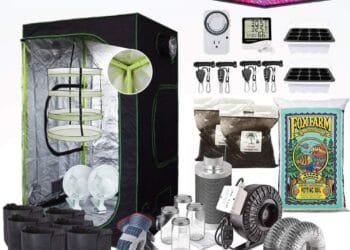Cannabis hydroponics is an innovative and efficient method of growing cannabis plants without the use of soil. This technique involves growing plants in a nutrient-rich water solution, providing them with all the necessary nutrients for optimal growth. Hydroponics offers several advantages over traditional soil-based cultivation, including faster growth rates, higher yields, and more control over nutrient delivery. In this comprehensive guide, we will explore the various aspects of cannabis hydroponics, from the basic principles to advanced techniques, ensuring you have all the information needed to succeed in this modern cultivation method.
What is Cannabis Hydroponics?
Cannabis hydroponics is the practice of growing cannabis plants using a water-based solution instead of soil. This method allows growers to deliver nutrients directly to the plant roots, resulting in faster and more efficient nutrient uptake. The absence of soil also reduces the risk of pests and diseases, making hydroponics a cleaner and more controlled growing environment.
The Benefits of Growing Cannabis Hydroponically
Hydroponic cannabis cultivation offers several benefits that make it an attractive option for both commercial and home growers:
- Faster Growth Rates: Plants grown hydroponically can grow up to 50% faster than those grown in soil due to the direct access to nutrients.
- Higher Yields: Hydroponic systems often produce higher yields as plants receive optimal nutrient levels and grow more efficiently.
- Better Control: Growers have precise control over the nutrient composition, pH levels, and water supply, allowing for customized growth conditions.
- Reduced Pest and Disease Risk: Without soil, the risk of soil-borne pests and diseases is significantly reduced.
- Water Efficiency: Hydroponic systems use less water than soil-based systems because water can be recirculated and reused.
Basic Components of a Hydroponic System
A hydroponic system consists of several basic components that work together to create an optimal growing environment for cannabis plants:
- Growing Medium: Although soil is not used, a growing medium like rockwool, coco coir, or clay pellets supports the plants and retains moisture.
- Nutrient Solution: A balanced mixture of essential nutrients dissolved in water provides the plants with everything they need for growth.
- Water Reservoir: This container holds the nutrient solution and supplies it to the plants.
- Pump: A pump circulates the nutrient solution, ensuring that it reaches the plant roots.
- Air Stone and Pump: These components oxygenate the nutrient solution, preventing root rot and promoting healthy root development.
- Grow Lights: Artificial lighting, such as LED or HPS lights, provides the plants with the necessary light spectrum for photosynthesis.

Different Types of Hydroponic Systems
There are several types of hydroponic systems, each with its unique method of delivering nutrients to the plants. Here are the most common types:
- Deep Water Culture (DWC): In DWC systems, plants are suspended in a nutrient-rich water solution with their roots submerged, while an air stone provides oxygen.
- Nutrient Film Technique (NFT): NFT systems involve a thin film of nutrient solution flowing over the plant roots in a slightly sloped channel, providing continuous access to nutrients and oxygen.
- Ebb and Flow (Flood and Drain): This system periodically floods the grow tray with nutrient solution and then drains it, allowing roots to absorb nutrients and oxygen alternately.
- Drip System: In a drip system, nutrient solution is delivered to the plant roots via drip emitters, providing precise control over nutrient and water delivery.
- Aeroponics: Aeroponic systems suspend plant roots in the air and mist them with a nutrient solution, offering maximum oxygen exposure and efficient nutrient uptake.
- Wick System: A passive system where a wick draws nutrient solution from a reservoir to the plant roots. It is simple but less efficient than other methods.
Choosing the Right Nutrients for Hydroponic Cannabis
Selecting the right nutrients is crucial for the success of a hydroponic cannabis grow. Cannabis plants require a specific balance of macro and micronutrients, including:
Macronutrients:
- Nitrogen (N): Essential for vegetative growth and leaf development.
- Phosphorus (P): Important for root development and flowering.
- Potassium (K): Crucial for overall plant health and disease resistance.
Micronutrients:
- Calcium (Ca), Magnesium (Mg), Sulfur (S): Vital for various physiological processes.
- Iron (Fe), Manganese (Mn), Zinc (Zn), Copper (Cu), Molybdenum (Mo), and Boron (B): Required in smaller quantities but essential for plant health.
Many nutrient brands offer hydroponic-specific formulations, ensuring that your plants receive the right balance of nutrients throughout their growth cycle. It’s important to follow the manufacturer’s recommendations for nutrient concentration and adjust as needed based on plant response and growth stage.
Setting Up Your Hydroponic Grow Room
Creating an optimal grow room environment is key to successful hydroponic cannabis cultivation. Here are the essential steps to set up your grow room:
- Space Selection: Choose a dedicated space that can accommodate your hydroponic system, grow lights, and ventilation equipment. A spare room, basement, or grow tent are popular options.
- Lighting: Install grow lights that provide the appropriate light spectrum for cannabis growth. LED lights are energy-efficient and produce less heat, making them ideal for indoor grows.
- Ventilation: Proper ventilation is crucial to maintain temperature and humidity levels. Use exhaust fans, intake fans, and oscillating fans to ensure adequate air circulation.
- Temperature and Humidity Control: Maintain a temperature range of 70-85°F (21-29°C) and a humidity level of 40-60% during the vegetative stage, lowering humidity to 30-50% during flowering.
- Water Quality: Use clean, filtered water to prevent contaminants from affecting your plants. Regularly check and adjust the pH and EC (electrical conductivity) of the nutrient solution.
Managing pH and EC Levels
Maintaining the correct pH and EC levels is critical for nutrient absorption and overall plant health in hydroponic systems:
- pH Level: The optimal pH range for hydroponic cannabis is 5.5-6.5. Use a pH meter to monitor and adjust the pH as needed using pH up or down solutions.
- EC Level: EC measures the concentration of nutrients in the solution. The ideal EC range for cannabis is 1.0-2.0 mS/cm during the vegetative stage and 1.5-2.5 mS/cm during flowering. Use an EC meter to monitor and adjust nutrient strength.
Common Challenges and Solutions in Hydroponic Cannabis Cultivation
While hydroponic cannabis cultivation offers many advantages, it also presents unique challenges. Here are some common issues and their solutions:
- Nutrient Imbalances: Regularly check and adjust nutrient levels to prevent deficiencies or toxicities. Use high-quality nutrients and follow feeding schedules.
- Root Rot: Ensure adequate oxygenation of the nutrient solution and maintain proper water temperature (65-75°F or 18-24°C) to prevent root rot.
- Pests and Diseases: Although less common in hydroponics, pests and diseases can still occur. Inspect plants regularly and use organic or chemical treatments as needed.
- Algae Growth: Prevent algae by keeping the grow area clean and light-proofing the nutrient reservoir.
Advanced Hydroponic Techniques
For experienced growers looking to maximize their hydroponic cannabis yields, several advanced techniques can be employed:
- SCROG (Screen of Green): This training method involves using a screen to create an even canopy, allowing for better light distribution and increased yields.
- LST (Low-Stress Training): Bending and tying down branches to promote horizontal growth, improving light penetration and airflow.
- Defoliation: Removing excess leaves to improve light penetration and air circulation, enhancing bud development.
- CO2 Enrichment: Increasing CO2 levels in the grow room can boost plant growth and yields, but requires careful monitoring and equipment.
Harvesting and Curing Hydroponic Cannabis
Proper harvesting and curing techniques are essential for maximizing the quality and potency of your hydroponic cannabis:
- Harvesting: When trichomes are mostly cloudy with some amber, it’s time to harvest. Cut the plants at the base and trim off fan leaves.
- Drying: Hang the trimmed plants upside down in a dark, well-ventilated room with a temperature of 60-70°F (15-21°C) and humidity of 50-60%. Drying typically takes 7-14 days.
- Curing: After drying, place the buds in airtight jars and store them in a cool, dark place. Open the jars daily for the first week to release moisture, then less frequently for the next few weeks. Curing can take several weeks to months and improves the flavor and potency of the buds.
Conclusion
Cannabis hydroponics is a modern and efficient method for growing cannabis that offers numerous benefits over traditional soil-based cultivation.
Read More: Mastering the Art of Harvesting Cannabis
Buy your seed: Royal Queen Seeds








